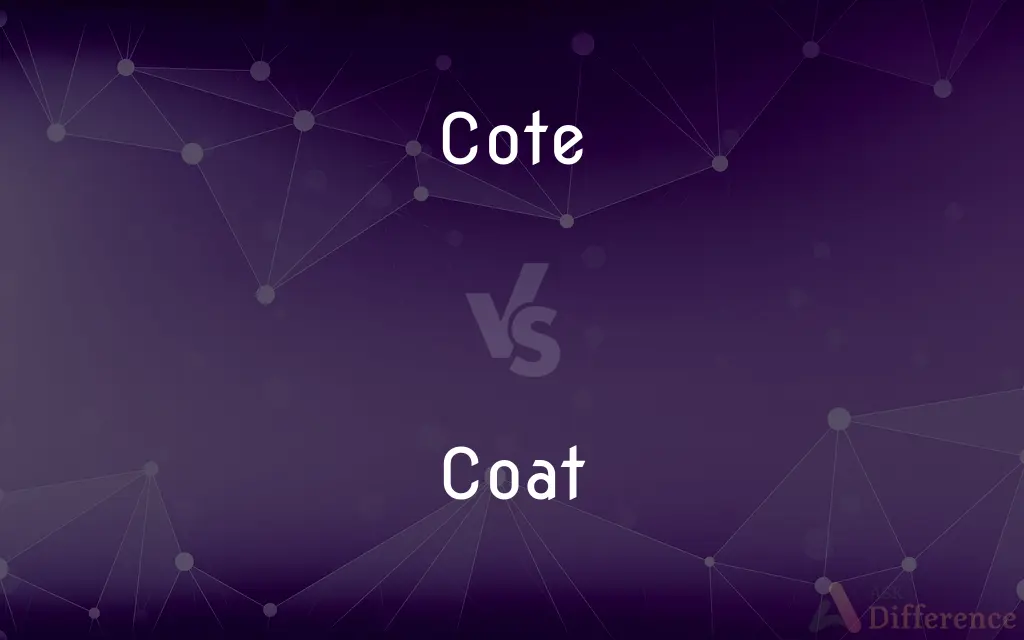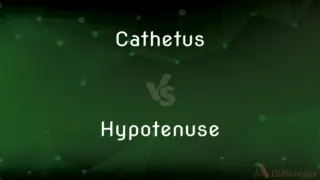Cote vs. Coat — What's the Difference?
By Tayyaba Rehman & Urooj Arif — Updated on March 27, 2024
Cote is a shelter for animals, especially birds and sheep, focusing on protection and housing; whereas a coat is an outer garment worn for warmth or as a fashion statement, covering the body and arms.

Difference Between Cote and Coat
Table of Contents
ADVERTISEMENT
Key Differences
Cote is traditionally understood as a small shelter or enclosure designed to house and protect animals, particularly pigeons and sheep. These structures provide a safe space for animals to live, breed, and be protected from the elements and predators. On the other hand, a coat refers to an item of clothing that is worn on the upper body over other garments. It is typically designed for warmth, protection against the weather, or fashion purposes, covering the wearer from the neck down to the hips or longer.
While cotes are specifically constructed to meet the needs of certain animals, providing them with a secure environment, coats are made from various materials, including wool, leather, and synthetic fibers, to serve different weather conditions and style preferences. Cotes serve a functional purpose in animal husbandry, whereas coats are an essential part of human wardrobe, reflecting personal style, cultural trends, and climate adaptation.
Cotes often require considerations of ventilation, size, and materials suitable for the animals they are designed for, highlighting the importance of tailored environments for animal welfare. Coats, in contrast, focus on the comfort, preferences, and needs of the person wearing them, with features like insulation, water resistance, and pockets adding to their utility and style.
In terms of maintenance, cotes need regular cleaning and maintenance to ensure a healthy environment for the animals. Coats require care based on their material, including washing, dry cleaning, and repairs, to maintain their appearance and functionality over time.
While the construction of cotes is a part of agricultural practices and animal husbandry, reflecting human interaction with animals, the design and fashion of coats are integral to the textile and fashion industry, illustrating human creativity and socio-economic status.
ADVERTISEMENT
Comparison Chart
Definition
A shelter for domesticated birds or small animals.
An outer garment worn on the upper body for warmth or style.
Primary Use
Providing protection and housing for animals.
Keeping the wearer warm or serving as a fashion item.
Materials
Wood, metal, or other durable materials suitable for animals.
Wool, cotton, leather, synthetic fibers, and more.
Maintenance
Requires cleaning and maintenance for animal health.
Needs washing, dry cleaning, or repairs depending on material.
Associated Industry
Agriculture and animal husbandry.
Fashion and textile industry.
Compare with Definitions
Cote
A pigeon cote is a structure for housing pigeons.
The old farmhouse had a wooden pigeon cote in the backyard.
Coat
A winter coat is designed for warmth during cold weather.
She bought a new winter coat in preparation for the snow.
Cote
Maintenance of a cote is crucial for animal health.
Regular cleaning of the cote keeps diseases at bay.
Coat
Coats come in various styles and materials.
Her velvet coat was admired at the party.
Cote
The design of a cote can vary based on its purpose.
The new cote was designed to accommodate more pigeons.
Coat
The fashion industry often sets coat trends.
The latest coat trends were highlighted in the fashion show.
Cote
A sheep cote protects sheep from the elements.
The shepherd repaired the sheep cote before winter.
Coat
Proper care can extend the life of a coat.
The wool coat was taken to the dry cleaners for special care.
Cote
Cotes are designed for the specific needs of the animals they house.
Building a cote requires understanding what the animal needs.
Coat
Trench coats are popular for rainy weather.
He wore his trench coat on the rainy day to stay dry.
Cote
A small shed or shelter for sheep or birds.
Coat
A sleeved outer garment extending from the shoulders to the waist or below.
Cote
To go around by the side of; skirt.
Coat
See suit coat.
Cote
A cottage or hut.
Coat
The hair or fur of an animal
A dog with a short coat.
Cote
A small structure built to contain domesticated animals such as sheep, pigs or pigeons.
Coat
The outer covering of a biological structure or organ
A seed coat.
Cote
Obsolete form of quote
Coat
The outer covering of a virus.
Cote
To go side by side with; hence, to pass by; to outrun and get before.
A dog cotes a hare.
Coat
A layer of material covering something else; a coating
A second coat of paint.
Cote
A cottage or hut.
Coat
To provide or cover with a coat.
Cote
A shed, shelter, or inclosure for small domestic animals, as for sheep or doves.
Watching where shepherds pen their flocks, at eve,In hurdled cotes.
Coat
To cover with a layer
Dust coated the table. I coated the wall with paint.
Cote
To go side by side with; hence, to pass by; to outrun and get before; as, a dog cotes a hare.
We coted them on the way, and hither are they coming.
Coat
(countable) An outer garment covering the upper torso and arms.Wp
Cote
To quote.
Coat
(countable) A covering of material, such as paint.Wp
Cote
A small shelter for domestic animals (as sheep or pigeons)
Coat
(countable) The fur or feathers covering an animal's skin.Wp
When the dog shed its coat, it left hair all over the furniture and the carpet.
Coat
Canvas painted with thick tar and secured round a mast or bowsprit to prevent water running down the sides into the hold (now made of rubber or leather).
Coat
(obsolete) A petticoat.
Coat
The habit or vesture of an order of men, indicating the order or office; cloth.
Coat
A coat of arms.Wp
Coat
A coat card.
Coat
(transitive) To cover with a coating of some material.
The frying pan was coated with a layer of non-stick material, making it easier to wash.
Coat
(transitive) To cover like a coat.
Coat
To clothe.
Coat
An outer garment fitting the upper part of the body; especially, such a garment worn by men.
Let eachHis adamantine coat gird well.
Coat
A petticoat.
Coat
The habit or vesture of an order of men, indicating the order or office; cloth.
Men of his coat should be minding their prayers.
She was sought by spirits of richest coat.
Coat
An external covering like a garment, as fur, skin, wool, husk, or bark; as, the horses coats were sleek.
Fruit of all kinds, in coatRough or smooth rined, or bearded husk, or shell.
Coat
A layer of any substance covering another; a cover; a tegument; as, the coats of the eye; the coats of an onion; a coat of tar or varnish.
Coat
Same as Coat of arms. See below.
Hark, countrymen! either renew the fight,Or tear the lions out of England's coat.
Coat
A coat card. See below.
Here's a trick of discarded cards of us! We were ranked with coats as long as old master lived.
Coat
To cover with a coat or outer garment.
Coat
To cover with a layer of any substance; as, to coat a jar with tin foil; to coat a ceiling.
Coat
An outer garment that has sleeves and covers the body from shoulder down; worn outdoors
Coat
A thin layer covering something;
A second coat of paint
Coat
Growth of hair or wool or fur covering the body of an animal
Coat
Put a coat on; cover the surface of; furnish with a surface;
Coat the cake with chocolate
Coat
Cover or provide with a coat
Coat
Form a coat over;
Dirt had coated her face
Common Curiosities
What materials are coats made from?
Coats can be made from wool, leather, cotton, synthetic fibers, and other materials suitable for clothing.
What is a coat?
A coat is an outer garment worn on the upper body, typically for warmth or as a fashion statement.
What is a cote?
A cote is a shelter designed for domesticated animals, particularly birds and small livestock, providing protection and a place to live.
What materials are used to make a cote?
Cotes are made from durable materials like wood or metal, suitable for housing animals.
What is the significance of coat trends?
Coat trends reflect changes in fashion, technology, and societal preferences.
Can cotes be used for any animal?
Cotes are typically designed for specific animals like pigeons and sheep, tailored to their needs.
How often do cotes need maintenance?
Cotes require regular maintenance for cleanliness and to ensure a healthy environment for the animals.
How do cotes and coats differ in purpose?
Cotes serve to protect and house animals, while coats are worn by people for warmth or fashion.
Are all coats designed for warmth?
While many coats are designed for warmth, others are worn for fashion or to protect against rain.
Do cotes affect animal health?
Yes, well-maintained cotes can significantly improve the health and wellbeing of housed animals.
How do climate conditions affect coat choices?
Climate conditions greatly influence the choice of coat, determining the need for warmth, water resistance, or breathability.
Are coats considered a fashion item?
Yes, coats are not only functional but also an important part of fashion and personal style.
Are there ethical considerations in coat production?
Yes, ethical considerations in coat production include the sourcing of materials and the environmental impact of manufacturing processes.
How do you care for a coat?
Care for a coat depends on its material, including washing, dry cleaning, or making repairs.
Can cotes be DIY projects?
Yes, with the right materials and knowledge, one can build a cote as a DIY project.
Share Your Discovery

Previous Comparison
Motel vs. Inn
Next Comparison
Cathetus vs. HypotenuseAuthor Spotlight
Written by
Tayyaba RehmanTayyaba Rehman is a distinguished writer, currently serving as a primary contributor to askdifference.com. As a researcher in semantics and etymology, Tayyaba's passion for the complexity of languages and their distinctions has found a perfect home on the platform. Tayyaba delves into the intricacies of language, distinguishing between commonly confused words and phrases, thereby providing clarity for readers worldwide.
Co-written by
Urooj ArifUrooj is a skilled content writer at Ask Difference, known for her exceptional ability to simplify complex topics into engaging and informative content. With a passion for research and a flair for clear, concise writing, she consistently delivers articles that resonate with our diverse audience.













































